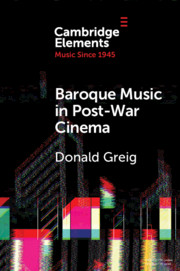Element contents
Baroque Music in Post-War Cinema
Published online by Cambridge University Press: 04 February 2021
Summary
- Type
- Element
- Information
- Series: Elements in Music since 1945Online ISBN: 9781108900614Publisher: Cambridge University PressPrint publication: 04 March 2021
Bibliography
- 13
- Cited by

